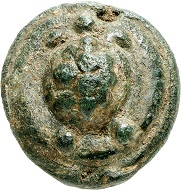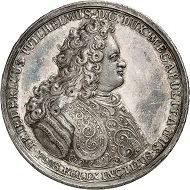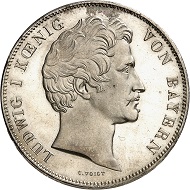04-10-2018 – 11-10-2018
Auction 311-315
Celtic Coins, Cologne, and Bavarian Gold Rarities: Fall Auctions at Künker
Nowadays, the auction house Künker is the place to go for specialized collectors selling their coin collections. Künker’s fall auctions, which will take place from October 5-12, 2018, give proof to that. Whether it may be extensive regional collections like the 390 lots of coinages from Mecklenburg, or small special collections like the 30 coins from the second Kipper time showing counter marks of the town of Strasbourg, or one that was compiled on unlimited resources like the collection of Bavarian gold rarities, or the coins of the town of Mainz, which Eberhard Link selected with a limited budget, the fall auctions at Künker demonstrate that every collector can create their own (numismatic) world.
No. 1335: Orders and decorations. Kingdom of Saxony. Dynastic Order of the Rue Crown, breast star, of Biennais (1807/8). Example from Emperor Napoleon taken from the “Waterloo loot”. Estimate: 75,000 euros.
Auction 311: Orders and decorations
The fall auctions at Künker will begin with the auction of orders and decorations from all over the world. Among other items, the first part of the Peter Groch collection and the Gunther Wiegrebe collection of Lippe will be sold. In addition, you will find a large batch of orders and decorations from Bulgaria between 1878 and 1991.
No. 1559: Ilercavonia-Dertosa (Tortosa / Tarragona). Semis, time of Tiberius. Likely unpublished variety of an extremely rare type. Green patina. Very fine + / Very fine. From Dr W. R. collection. Estimate: 1,000 euros.
Auction 312: Coins from the ancient world
The first half of Künker’s auction catalog 312 is dedicated to the first part of the Dr W. R. collections. It was compiled with scholarly meticulousness and the collector was happy cataloging it. The detailed explanations illustrate the collector’s enthusiasm.
The first part deals with coins from the Iberian Peninsula. It encompasses circa 170 lots. The geographical spectrum ranges rom A like Abdera, today’s Almeria, to V like Ventipo, today’s Cordoba. But there is one thing all of these coins have in common: their extraordinary quality. The collector paid close attention to the fine patina.
No. 1719: Catuvellauni and Trinovantes (Britain). Cunobeline, 8-41 AD. Gold stater. 20-41. Camulodunum (= Colchester). Very rare variety. Extremely fine. From Dr W. R. collection. Estimate: 2,500 euros.
This part if followed by Celtic coins of the Dr W. R. collection. The collector also chose these coins with a deep understanding of excellent quality; all coins are sharply struck, well-centered, and very often the only known specimen on which the inscription is entirely readable. In terms of geography, the focus of this collection lies on Britain and Gaul although some examples from Switzerland and Southern Germany were incorporated, too.
No. 2188: Mende (Macedonia). Tetradrachm, around 423. From Margaretha Ley collection, Numismatik Lanz auction 70 (1994), No. 51. Very rare. Extremely fine. Estimate: 40,000 euros.
Next up are Celtic, Greek, Roman, and Byzantine coins stemming from various collections. Of course, connoisseurs will recognize numerous rarities among them like the archaic stater from Caulonia with a provenance that dates back to 1923, or a tetradrachm from the Macedonian town of Mende that beautifully depicts a tipsy Dionysus on his donkey.
No. 2321: Ionia. Electrum hecte (1/6 stater), 7th / 6th cent. Very rare. Extremely fine. From Eberhard Link collection. Estimate: 600 euros.
A variety of early electrum coinages from unknown mints in Ionia and Lydia originate from the Eberhard Link collection, a name that will be mentioned quite a few times in this auction preview. His collector’s motto was “You shouldn’t purchase a coin if you can’t give a presentation on it” and it comes into play regarding these early electrum coins as well. After all, the 120 carefully selected lots do take us back to the beginning of mintage.
No. 2622: Roman Republic. Sextans, 265-242. Nearly extremely fine. From Eberhard Link collection. Estimate: 150 euros.
It is precisely this beginning of the use of money that Eberhard Link was very interested in. Therefore, it comes as no surprise that a second part of his collection was dedicated to Italian aes grave. Long after the Greeks had established an elaborated coin system, the value of aes grave was still based on the value of its material.
No. 2926: Septimius Severus, 193-211. Aureus, Emesa, 194. From Egon Beckenbauer collection, Kastner auction 10 (1976), No. 168. Extremely rare. FDC. Estimate: 35,000 euros.
Of course, the Künker auction of ancient coins also has numerous showpieces to offer for all those who are fans of Roman and Byzantine coinages. Let us just mention the exquisitely preserved aurei of Otho, Domitian, Faustina, and Septimius Severus.
The Byzantium section includes, among many other items, one very special rarity: a unique semis – possibly a semissis weight in gold – depicting a monogram of emperor Marcian.
No. 3724: Cologne. Gold strike of 4 gold gulden from the dies of the dreikönigstaler n.d. (ca 1620). Extremely rare. Very fine. From Bankhaus Sal. Oppenheim collection. Estimate: 50,000 euros.
Auction 313: The minted history of Cologne
The Bankhaus Salomon Oppenheim collection of coinages from Cologne will be auctioned off on October 9, 2018 before noon. It offers an impressive overview of the numismatic testimonies concerning the history of Cologne and starts off with an aureus depicting the portrait of the namesake of Cologne, Agrippina the Younger. The time span covered reaches all the way to the French coins of the Duchy of Berg. Whether it may be coins minted by the imperial mint, the archdiocese of Cologne, by the town, or medals referring to the history of Cologne: those who collect Cologne won’t be able to ignore this auction. Others, too, who just appreciate beautiful and rare coins, will acknowledge this selection.
The material is completed by a large series of rare coin scales.
No. 4099: Mecklenburg-Schwerin. Frederick William. 1692-1713. Silver medal 1701 by Z. D. Kelp and B. Meyer on the occasion of the Treaty of Hamburg. Extremely rare. Extremely fine. Collection Mecklenburg. Estimate: 10,000 euros.
Auction 314: Collection of Mecklenburgian coins – Saxonia in Nummis – Coins and medals from the Middle Ages and the Modern period
Several smaller and bigger collections will be sold at auction 314. It will begin after auction 313 on October 9, 2018 before noon with an extensive collection of coinages from Mecklenburg. From the 14th to the 20th century: the duchy’s history is reflected in the coinages of the stem and branch lines of Mecklenburg-Güstrow, Mecklenburg-Schwerin, and Mecklenburg-Strelitz. In addition, coins and medals which are connected to Mecklenburg geographically or regarding their topic will also be offered.
No. 5932: Saxe-Gotha. Frederick I, 1675-1680-1691. Thick double reichstaler 1691, Gotha. Unique? Very fine to extremely fine. Estimate: 25,000 euros.
The second collection being sold at auction 314 is called “Saxonia in Nummis”. It encompasses 535 lots, including numerous rarities: For example, the klappmützentaler of Frederick II, the guldengroschen depicting the portrait of Frederick the Wise, a triple reichstaler from 1650 celebrating the Peace of Westphalia, the ordenstaler of August the Strong, the schmetterlingstaler, the half schmetterlingstaler, the klippe weighing one reichstaler on the occasion of the Schnepper Society shooting of 1719, and the famous medal showing the family tree. Simply put, those who are looking for rarities, will encounter overwhelming offerings, and that does not only apply to items in the “Saxonia in Nummis” section. The coins and medals stemming from various collections which are being sold in auction 314 and 315 also contain trouvailles for all those who are interested in Saxony.
And please do not let yourself be deceived by the selection of presented items: numerous lots are listed at lower three-digit estimate.
No. 5053: Bavaria. Louis I, 1825-1848. Double convention taler 1848 celebrating handing over the crown to his son. The rarest Bavarian double geschichtstaler. Nearly FDC. Estimate: 3,000 euros.
And just like that, we have arrived at the German coins and medals section. Here you will find both numerous individual pieces as well as several collections.
Very popular among collectors are the geschichtstaler of the Bavarian king Louis I. In this auction, Künker will offer a small batch of about 80 exemplars.
No. 5512: Jülich-Berg. John III, 1511-1539. Guldengroschen n. d., probably Mühlheim mint. Extremely rare. Very fine to extremely fine. Estimate: 60,000 euros.
The outstanding unique specimen of this auction originates from Jülich-Berg. It is a guldengroschen from Duke John III. It depicts the conversion of Saint Hubertus including many details: the hunter kneels in front of a deer that carries a cross in its antlers.
The J. G. collection of Moneta Radasponensis contains almost 200 lots of medieval coins from the town of Regensburg. Those who collect Bavarian coins have to make their bids here as Regensburg was the first mint of the Duchy of Bavaria after the house of Carolingians had become extinct and the Bavarian dukes had become more influential.
Let us also take a look at world coins and medals. Hidden here is yet another small special collection, one which required a lot of time and expertise to acquire. The authorities of Strasbourg refused to participate in the great coin devaluation of the second Kipper period. They did not want to hurt their own citizens. However, in order to keep all of this bad money away from their own market, the city had to trial and mark those coins in order to enable them to circulate within their city walls. Counter marks on foreign coins give proof to this economic method. You will find a collection of about 30 counter-marked coins in the France section of catalog 314.
No. 7358: Hungary / Transylvania. Gabriel Bethlen, 1613-1629. 10 ducats 1616. Very rare. Nearly extremely fine. Estimate: 25,000 euros.
Auction 315: World gold coins and medals, among others a collection of Bavarian gold rarities and the Eberhard Link collection of Mainz / German coins after 1871 / Russian coins and medals
On Thursday afternoon, gold coinages from all over the world will be auctioned off. We resort to only presenting the highlights here, like a small selection of representational papal heavy gold coins: one quadrupla each from Clement VIII, Paul V, and Innocent X.
A contemporary of Paul V was Gabriel Bethlen, Prince of Transylvania and leader of the anti-Habsburg uprisings. Auction 315 offers a gorgeous 10 ducat from 1616 that Bethlen had minted.
No. 7702: Bavaria. Maximilian I, 1598-1651. 8 ducats 1598, Munich, on the occasion of his homage. Very rare. Extremely fine. Collection of Bavarian gold rarities. Estimate: 30,000 euros.
The gold coinages of the Holy Roman Empire and Austria are followed by gold coins and medals from Germany. Another highlight awaits you here: a spectacular collection of 180 lots featuring Bavarian gold rarities. Where to begin? The numerous multiple ducats of perfect grade are simply breathtaking.
No. 7750: Bavaria. Charles Albert, 1726-1745, Emperor Charles II since 1742. 20 ducats 1739, Munich. Extremely rare. Extremely fine. Collection of Bavarian gold rarities. Estimate: 50,000 euros.
The time span covered here ranges from Duke William V up to Prince Regent Luitpold. Beautiful portraits from the time when the Renaissance transitioned into the Baroque age will warm the hearts of art lovers. Those who are interested in history will also come into their own. The coinage of Charles Albert, who was elected emperor in 1742 and thus became known as Charles VII, is especially well-documented. A vast number of river gold ducats is also looking for a new home.
No. 8066: Mainz. John I of Luxembourg-Ligny, 1371-1373. Goldgulden n. d., Bingen. Very rare. Very fine +. Eberhard Link collection. Estimate: 2,000 euros.
Yet another collection will be sold in auction 315, namely the Eberhard Link collection of gold and silver coins by the archbishops of Mainz struck at the Bingen mint. The well-informed collector chose a very interesting field, as Mainz became an archdiocese in 782(!) already. The bishops of Mainz held the position of arch-chancellor under the German emperor for centuries and acted as regent during the imperial sede vacante.
Of course, Mainz was also an important commercial city with a lot of influence on the Coin Union of the Rhine. The Eberhard Link collection documents all of this.
No. 8044: Hamburg. Gold medal 1842, unsigned, G. Loos workshop. Probably the only example on the market. Extremely fine. Estimate: 20,000 euros.
These two collections are not the only ones which allow for some marveling at German gold coins. Many rarities will also be sold.
No. 8691: German Empire. Saxony. Albert, 1873-1902. 20 marks 1877. Very rare year. Extremely fine +. Estimate: 30,000 euros.
The auction will be rounded off with German coins after 1871 as well as Russian coins and medals.
Catalogs can be ordered at Künker, Nobbenburgerstr. 4a, 49076 Osnabrück (Germany); Phone: +49 541 / 96 20 20; Fax: +49 541 96 20 222; or via e-mail. The auction can also be viewed online.








































